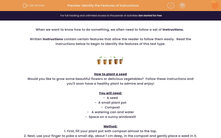When we want to know how to do something, we often need to follow a set of instructions.
Written instructions contain certain features that allow the reader to follow them easily. Read the instructions below to begin to identify the features of this text type.

How to plant a seed
Would you like to grow some beautiful flowers or delicious vegetables? Follow these instructions and you'll soon have a healthy plant to admire and enjoy!
You will need:
- A seed
- A small plant pot
- Compost
- A watering can and water
- Space on a sunny windowsill
Method:
1. First, fill your plant pot with compost almost to the top.
2. Next, use your finger to poke a small dip, about 1 cm deep, in the compost and gently place a seed in it.
3. Cover the seed with compost and carefully pat it down.
4. Use your watering can to pour water on the compost until it is moist but not soaking wet.
5. Place your pot on a sunny windowsill.
6. Over the next few weeks, keep an eye on your seed and water it every day or so. Don't let the compost get too dry!
7. Finally, once your plant has a few leaves and has grown tall and strong, you can plant it outside.
Enjoy your beautiful blooms and tasty vegetables!
.jpg)
As you can see, instructions are written in a particular way.
They use the following:
- A title
- A short introduction, often beginning with a question
- Subheadings to direct the reader to the equipment and method
- Bullet points to list equipment
- Numbered points to list the steps in chronological order (from first to last)
- A short conclusion
In addition, instructions use certain language features:
- Imperative verbs are used. You may have heard these called bossy verbs before. They are words like put, lift, pour. These are used instead of other forms of the verb (like 'you should put', 'pouring', etc.)
- Adverbs (carefully, gently) are used to tell the reader how to do something.
- Time conjunctions (first, next, finally, while) are used in some of the steps.
That's a lot to remember! As we go through the questions, you can come back to this page at any time by clicking the red help button.









